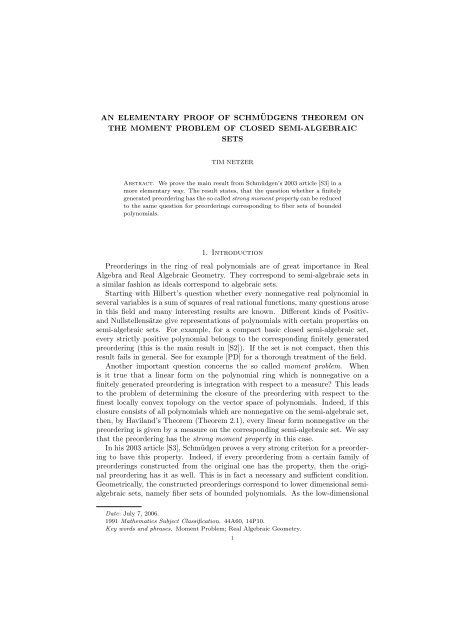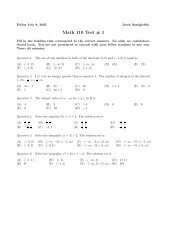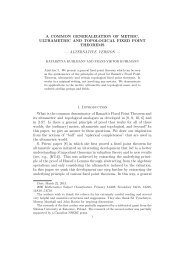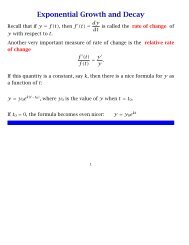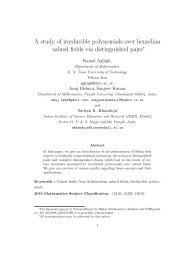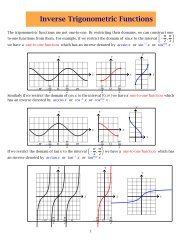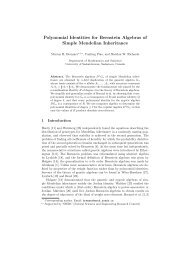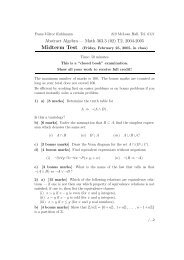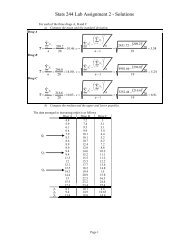An Elementary Proof of Schmüdgen's Theorem on the Moment ...
An Elementary Proof of Schmüdgen's Theorem on the Moment ...
An Elementary Proof of Schmüdgen's Theorem on the Moment ...
You also want an ePaper? Increase the reach of your titles
YUMPU automatically turns print PDFs into web optimized ePapers that Google loves.
AN ELEMENTARY PROOF OF SCHMÜDGENS THEOREM ON<br />
THE MOMENT PROBLEM OF CLOSED SEMI-ALGEBRAIC<br />
SETS<br />
TIM NETZER<br />
Abstract. We prove <strong>the</strong> main result from Schmüdgen’s 2003 article [S3] in a<br />
more elementary way. The result states, that <strong>the</strong> questi<strong>on</strong> whe<strong>the</strong>r a finitely<br />
generated preordering has <strong>the</strong> so called str<strong>on</strong>g moment property can be reduced<br />
to <strong>the</strong> same questi<strong>on</strong> for preorderings corresp<strong>on</strong>ding to fiber sets <str<strong>on</strong>g>of</str<strong>on</strong>g> bounded<br />
polynomials.<br />
1. Introducti<strong>on</strong><br />
Preorderings in <strong>the</strong> ring <str<strong>on</strong>g>of</str<strong>on</strong>g> real polynomials are <str<strong>on</strong>g>of</str<strong>on</strong>g> great importance in Real<br />
Algebra and Real Algebraic Geometry. They corresp<strong>on</strong>d to semi-algebraic sets in<br />
a similar fashi<strong>on</strong> as ideals corresp<strong>on</strong>d to algebraic sets.<br />
Starting with Hilbert’s questi<strong>on</strong> whe<strong>the</strong>r every n<strong>on</strong>negative real polynomial in<br />
several variables is a sum <str<strong>on</strong>g>of</str<strong>on</strong>g> squares <str<strong>on</strong>g>of</str<strong>on</strong>g> real rati<strong>on</strong>al functi<strong>on</strong>s, many questi<strong>on</strong>s arose<br />
in this field and many interesting results are known. Different kinds <str<strong>on</strong>g>of</str<strong>on</strong>g> Positivand<br />
Nullstellensätze give representati<strong>on</strong>s <str<strong>on</strong>g>of</str<strong>on</strong>g> polynomials with certain properties <strong>on</strong><br />
semi-algebraic sets. For example, for a compact basic closed semi-algebraic set,<br />
every strictly positive polynomial bel<strong>on</strong>gs to <strong>the</strong> corresp<strong>on</strong>ding finitely generated<br />
preordering (this is <strong>the</strong> main result in [S2]). If <strong>the</strong> set is not compact, <strong>the</strong>n this<br />
result fails in general. See for example [PD] for a thorough treatment <str<strong>on</strong>g>of</str<strong>on</strong>g> <strong>the</strong> field.<br />
<str<strong>on</strong>g>An</str<strong>on</strong>g>o<strong>the</strong>r important questi<strong>on</strong> c<strong>on</strong>cerns <strong>the</strong> so called moment problem. When<br />
is it true that a linear form <strong>on</strong> <strong>the</strong> polynomial ring which is n<strong>on</strong>negative <strong>on</strong> a<br />
finitely generated preordering is integrati<strong>on</strong> with respect to a measure? This leads<br />
to <strong>the</strong> problem <str<strong>on</strong>g>of</str<strong>on</strong>g> determining <strong>the</strong> closure <str<strong>on</strong>g>of</str<strong>on</strong>g> <strong>the</strong> preordering with respect to <strong>the</strong><br />
finest locally c<strong>on</strong>vex topology <strong>on</strong> <strong>the</strong> vector space <str<strong>on</strong>g>of</str<strong>on</strong>g> polynomials. Indeed, if this<br />
closure c<strong>on</strong>sists <str<strong>on</strong>g>of</str<strong>on</strong>g> all polynomials which are n<strong>on</strong>negative <strong>on</strong> <strong>the</strong> semi-algebraic set,<br />
<strong>the</strong>n, by Haviland’s <str<strong>on</strong>g>Theorem</str<strong>on</strong>g> (<str<strong>on</strong>g>Theorem</str<strong>on</strong>g> 2.1), every linear form n<strong>on</strong>negative <strong>on</strong> <strong>the</strong><br />
preordering is given by a measure <strong>on</strong> <strong>the</strong> corresp<strong>on</strong>ding semi-algebraic set. We say<br />
that <strong>the</strong> preordering has <strong>the</strong> str<strong>on</strong>g moment property in this case.<br />
In his 2003 article [S3], Schmüdgen proves a very str<strong>on</strong>g criteri<strong>on</strong> for a preordering<br />
to have this property. Indeed, if every preordering from a certain family <str<strong>on</strong>g>of</str<strong>on</strong>g><br />
preorderings c<strong>on</strong>structed from <strong>the</strong> original <strong>on</strong>e has <strong>the</strong> property, <strong>the</strong>n <strong>the</strong> original<br />
preordering has it as well. This is in fact a necessary and sufficient c<strong>on</strong>diti<strong>on</strong>.<br />
Geometrically, <strong>the</strong> c<strong>on</strong>structed preorderings corresp<strong>on</strong>d to lower dimensi<strong>on</strong>al semialgebraic<br />
sets, namely fiber sets <str<strong>on</strong>g>of</str<strong>on</strong>g> bounded polynomials. As <strong>the</strong> low-dimensi<strong>on</strong>al<br />
Date: July 7, 2006.<br />
1991 Ma<strong>the</strong>matics Subject Classificati<strong>on</strong>. 44A60, 14P10.<br />
Key words and phrases. <strong>Moment</strong> Problem; Real Algebraic Geometry.<br />
1
2 TIM NETZER<br />
case is <str<strong>on</strong>g>of</str<strong>on</strong>g>ten better understood (see for example [KM] and [KMS]), <strong>the</strong> Schmüdgen<br />
criteri<strong>on</strong> can be applied in many cases successfully.<br />
The pro<str<strong>on</strong>g>of</str<strong>on</strong>g> in [S3] uses deep results from functi<strong>on</strong>al analysis. A direct integral<br />
decompositi<strong>on</strong> <str<strong>on</strong>g>of</str<strong>on</strong>g> a GNS representati<strong>on</strong> is used to decompose a linear form <strong>on</strong> <strong>the</strong><br />
polynomial ring into an integral <str<strong>on</strong>g>of</str<strong>on</strong>g> linear forms. The applied methods are from [S1]<br />
and [D]. In this work we give a more elementary pro<str<strong>on</strong>g>of</str<strong>on</strong>g> <str<strong>on</strong>g>of</str<strong>on</strong>g> <strong>the</strong> <strong>the</strong>orem. We also<br />
decompose a linear form into an integral <str<strong>on</strong>g>of</str<strong>on</strong>g> linear forms. These linear forms are<br />
c<strong>on</strong>structed from functi<strong>on</strong>s emerging from <strong>the</strong> Rad<strong>on</strong>-Nikodym <str<strong>on</strong>g>Theorem</str<strong>on</strong>g>.<br />
Acknowledgements<br />
I would like to thank Dr. Markus Schweigh<str<strong>on</strong>g>of</str<strong>on</strong>g>er and Pr<str<strong>on</strong>g>of</str<strong>on</strong>g>. Robert Denk from<br />
K<strong>on</strong>stanz University for many interesting and helpful discussi<strong>on</strong>s <strong>on</strong> <strong>the</strong> topic <str<strong>on</strong>g>of</str<strong>on</strong>g><br />
this work.<br />
Financial support by <strong>the</strong> Studienstiftung des Deutschen Volkes is greatfully acknowledged.<br />
During <strong>the</strong> work <strong>on</strong> this article, Pr<str<strong>on</strong>g>of</str<strong>on</strong>g>. Murray Marshall from <strong>the</strong> University <str<strong>on</strong>g>of</str<strong>on</strong>g><br />
Saskatchewan found a similar approach to <strong>the</strong> problem independently.<br />
2. Notati<strong>on</strong>s and Preliminaries<br />
For n ∈ N c<strong>on</strong>sider <strong>the</strong> real polynomial ring R[X1, . . . , Xn], which we will denote<br />
by R[X] in <strong>the</strong> following. Later we will also use <strong>the</strong> polynomial ring R[Y ] =<br />
R[Y1, . . . , Ys] for some s ∈ N. To distinguish elements, we will use capitals for<br />
elements from R[Y ] and lowercase letters for elements from R[X].<br />
For finitely many polynomials f1, . . . , fr ∈ R[X] we write T = T (f1, . . . , fr) for<br />
<strong>the</strong> preordering generated by <strong>the</strong>se polynomials, which c<strong>on</strong>sists <str<strong>on</strong>g>of</str<strong>on</strong>g> all finite sums <str<strong>on</strong>g>of</str<strong>on</strong>g><br />
elements <str<strong>on</strong>g>of</str<strong>on</strong>g> <strong>the</strong> form<br />
σf e1<br />
1<br />
· · · f er<br />
r ,<br />
where σ is a sum <str<strong>on</strong>g>of</str<strong>on</strong>g> squares <str<strong>on</strong>g>of</str<strong>on</strong>g> real polynomials and all ei ∈ {0, 1}. On <strong>the</strong> geometric<br />
side, we have <strong>the</strong> so called basic closed semi-algebraic set W = W (f1, . . . , fr)<br />
corresp<strong>on</strong>ding to f1, . . . , fr, defined as<br />
W = {x ∈ R n | f1(x) ≥ 0, . . . , fr(x) ≥ 0} .<br />
We <strong>the</strong>n c<strong>on</strong>sider <strong>the</strong> saturati<strong>on</strong> <str<strong>on</strong>g>of</str<strong>on</strong>g> T , denoted by T sat , c<strong>on</strong>sisting <str<strong>on</strong>g>of</str<strong>on</strong>g> all real polynomials<br />
n<strong>on</strong>negative <strong>on</strong> W . Note that T sat depends <strong>on</strong>ly <strong>on</strong> W , whereas T can be<br />
different for different sets <str<strong>on</strong>g>of</str<strong>on</strong>g> generators defining <strong>the</strong> same set W .<br />
Obviously T ⊆ T sat and T sat is again a preordering, i.e. T sat is closed under additi<strong>on</strong>,<br />
multiplicati<strong>on</strong> and c<strong>on</strong>tains all squares <str<strong>on</strong>g>of</str<strong>on</strong>g> polynomials. The relati<strong>on</strong> between<br />
T and T sat is an important object <str<strong>on</strong>g>of</str<strong>on</strong>g> study in Real Algebraic Geometry.<br />
As R[X] is a real vector space and T is a c<strong>on</strong>vex c<strong>on</strong>e, we define<br />
T ∨ := {L: R[X] → R linear | L(T ) ⊆ [0, ∞) and L(1) = 1} ,<br />
<strong>the</strong> algebraic dual c<strong>on</strong>e <str<strong>on</strong>g>of</str<strong>on</strong>g> T . As explained in [KM], L(1) > 0 holds for all L = 0<br />
which are n<strong>on</strong>negative <strong>on</strong> T . Therefore <strong>the</strong> c<strong>on</strong>diti<strong>on</strong> L(1) = 1 in <strong>the</strong> definiti<strong>on</strong> <str<strong>on</strong>g>of</str<strong>on</strong>g><br />
T ∨ can be ensured for those forms by skaling with a positive real and it does not<br />
affect any <str<strong>on</strong>g>of</str<strong>on</strong>g> <strong>the</strong> following c<strong>on</strong>siderati<strong>on</strong>s.<br />
We define <strong>the</strong> double dual c<strong>on</strong>e<br />
T ∨∨ := {p ∈ R[X] | L(p) ≥ 0 for all L ∈ T ∨ } .
AN ELEMENTARY PROOF OF SCHMÜDGENS THEOREM 3<br />
T ∨∨ is <strong>the</strong> closure <str<strong>on</strong>g>of</str<strong>on</strong>g> T with respect to <strong>the</strong> finest locally c<strong>on</strong>vex topology <strong>on</strong> <strong>the</strong><br />
vector space R[X], it is again a preordering and we have<br />
T ⊆ T ∨∨ ⊆ T sat ,<br />
<strong>the</strong> first inclusi<strong>on</strong> being obvious, <strong>the</strong> sec<strong>on</strong>d <strong>on</strong>e coming from <strong>the</strong> fact that evaluati<strong>on</strong><br />
in x ∈ W defines an element from T ∨ . See [KM] and [KMS] for a more<br />
thorough discussi<strong>on</strong>.<br />
Now <strong>on</strong>e is interested in <strong>the</strong> relati<strong>on</strong> between T ∨∨ and T sat . In particular, <strong>on</strong>e<br />
wants to know whe<strong>the</strong>r T ∨∨ = T sat holds. Following <strong>the</strong> notati<strong>on</strong> in [S3], we<br />
say that <strong>the</strong> preordering T has <strong>the</strong> str<strong>on</strong>g moment property (SMP) in this case.<br />
The importance <str<strong>on</strong>g>of</str<strong>on</strong>g> this noti<strong>on</strong> is obvious from <strong>the</strong> following classical <strong>the</strong>orem by<br />
Haviland [H]:<br />
<str<strong>on</strong>g>Theorem</str<strong>on</strong>g> 2.1 (Haviland). Let K be a closed subset <str<strong>on</strong>g>of</str<strong>on</strong>g> Rn and L: R[X] → R be<br />
a linear form. Then L is given by a positive Borel measure ν <strong>on</strong> K, i.e. L(f) =<br />
fdν for all f ∈ R[X], if and <strong>on</strong>ly if L(f) ≥ 0 for all f n<strong>on</strong>negative <strong>on</strong> K.<br />
K<br />
So if T has (SMP), <strong>the</strong>n every L ∈ T ∨ is n<strong>on</strong>negative <strong>on</strong> T sat and is given, by<br />
Haviland’s <str<strong>on</strong>g>Theorem</str<strong>on</strong>g>, by a positive Borel measure <strong>on</strong> W . As it is much easier to<br />
check n<strong>on</strong>negativity <strong>on</strong> T than <strong>on</strong> T sat , (SMP) is a useful property.<br />
Schmüdgen proved in [S2] that T has (SMP) whenever W is compact, independent<br />
<str<strong>on</strong>g>of</str<strong>on</strong>g> <strong>the</strong> choice <str<strong>on</strong>g>of</str<strong>on</strong>g> generators. Indeed, he proved a bit more without bringing it<br />
up explicitly. Denote by BW <strong>the</strong> ring <str<strong>on</strong>g>of</str<strong>on</strong>g> all polynomials which are bounded <strong>on</strong> W .<br />
Then we have, even if W is not compact:<br />
<str<strong>on</strong>g>Theorem</str<strong>on</strong>g> 2.2 (Schmüdgen). BW ∩ T sat ⊆ T ∨∨ .<br />
If W is compact, <strong>the</strong>n every polynomial is bounded <strong>on</strong> W and <strong>the</strong>refore <strong>the</strong><br />
<str<strong>on</strong>g>Theorem</str<strong>on</strong>g> shows T ∨∨ = T sat .<br />
As this result is not stated explicitly in [S2], we give a short sketch <str<strong>on</strong>g>of</str<strong>on</strong>g> <strong>the</strong> pro<str<strong>on</strong>g>of</str<strong>on</strong>g>.<br />
<str<strong>on</strong>g>Pro<str<strong>on</strong>g>of</str<strong>on</strong>g></str<strong>on</strong>g>. For every b ∈ BW and every L ∈ T ∨ we have<br />
(1) L(b 2 ) ≤ b 2 ∞,<br />
where b ∞ denotes <strong>the</strong> supremum <str<strong>on</strong>g>of</str<strong>on</strong>g> b <strong>on</strong> W . This is shown in <strong>the</strong> pro<str<strong>on</strong>g>of</str<strong>on</strong>g> <str<strong>on</strong>g>of</str<strong>on</strong>g> <str<strong>on</strong>g>Theorem</str<strong>on</strong>g><br />
1 in [S2] or in <strong>the</strong> pro<str<strong>on</strong>g>of</str<strong>on</strong>g> <str<strong>on</strong>g>of</str<strong>on</strong>g> Propositi<strong>on</strong> 2 in [S3]. It uses <strong>the</strong> Positivstellensatz<br />
and <strong>the</strong> <strong>on</strong>e dimensi<strong>on</strong>al Hamburger moment problem.<br />
So if b is n<strong>on</strong>negative <strong>on</strong> W in additi<strong>on</strong>, for any δ > b ∞ we have<br />
<strong>on</strong> W , and so<br />
−δ ≤ b − δ < 0<br />
L((b − δ) 2 ) ≤ δ 2 ,<br />
using (1). This yields 0 ≤ L(b 2 ) ≤ 2δL(b), so L(b) ≥ 0 since δ > 0. This shows<br />
b ∈ T ∨∨ . <br />
The n<strong>on</strong>-compact case is investigated by Schmüdgen in [S3]. He reduces <strong>the</strong><br />
questi<strong>on</strong> whe<strong>the</strong>r T has (SMP) to <strong>the</strong> same questi<strong>on</strong> for preorderings corresp<strong>on</strong>ding<br />
to lower dimensi<strong>on</strong>al semi-algebraic sets, namely fibers <str<strong>on</strong>g>of</str<strong>on</strong>g> polynomials bounded <strong>on</strong><br />
W .
4 TIM NETZER<br />
3. Main <str<strong>on</strong>g>Theorem</str<strong>on</strong>g><br />
For <strong>the</strong> whole secti<strong>on</strong> fix f1, . . . , fr ∈ R[X] and c<strong>on</strong>sider T , W and BW as in <strong>the</strong><br />
secti<strong>on</strong> before. In additi<strong>on</strong>, we fix bounded polynomials h1, . . . , hs ∈ BW . We will<br />
<str<strong>on</strong>g>of</str<strong>on</strong>g>ten write h in <strong>the</strong> following if we refer to <strong>the</strong> s-tuple h1, . . . , hs. The set<br />
h(W ) := {(h1(x), . . . , hs(x)) | x ∈ W }<br />
is a bounded subset <str<strong>on</strong>g>of</str<strong>on</strong>g> R s , and its closure with respect to <strong>the</strong> usual topology is<br />
denoted by h(W ).<br />
For any λ = (λ1, . . . , λs) ∈ R s we c<strong>on</strong>sider <strong>the</strong> preordering<br />
Tλ := T + Iλ,<br />
where Iλ := (h1 − λ1, . . . , hs − λs) is <strong>the</strong> ideal generated by <strong>the</strong> hi − λi. Tλ is again<br />
a finitely generated preordering, as every polynomial is a difference <str<strong>on</strong>g>of</str<strong>on</strong>g> two squares<br />
<str<strong>on</strong>g>of</str<strong>on</strong>g> polynomials it is indeed generated by f1, . . . , fr, ±(h1 −λ1), . . . , ±(hs −λs). This<br />
shows that <strong>the</strong> basic closed semi-algebraic set Wλ corresp<strong>on</strong>ding to Tλ is just W<br />
intersected with <strong>the</strong> zero set <str<strong>on</strong>g>of</str<strong>on</strong>g> Iλ.<br />
Now Schmüdgen proved <strong>the</strong> remarkable <strong>the</strong>orem, that if Tλ has (SMP) for all<br />
λ ∈ h(W ), <strong>the</strong>n so does T ([S3], see Corollary 3.3 below). He uses direct integral<br />
decompositi<strong>on</strong>s <str<strong>on</strong>g>of</str<strong>on</strong>g> ∗-represenati<strong>on</strong>s <str<strong>on</strong>g>of</str<strong>on</strong>g> ∗-algebras. Indeed, he proved <strong>the</strong> following<br />
slightly str<strong>on</strong>ger <strong>the</strong>orem, which we will prove here in an more elementary way:<br />
<str<strong>on</strong>g>Theorem</str<strong>on</strong>g> 3.1.<br />
T ∨∨ = <br />
λ∈h(W )<br />
Before we begin with <strong>the</strong> pro<str<strong>on</strong>g>of</str<strong>on</strong>g>, we explain some c<strong>on</strong>structi<strong>on</strong>s that we will use.<br />
We fix L ∈ T ∨ and define linear forms Lp <strong>on</strong> R[Y ] = R[Y1, . . . , Ys] for any p ∈ R[X]<br />
in <strong>the</strong> following way:<br />
T ∨∨<br />
λ<br />
Lp : R[Y ] → R; F ↦→ L(F (h)p).<br />
Here, F (h) is an abbreviati<strong>on</strong> for F (h1, . . . , hs), where F ∈ R[Y ]. Since p =<br />
2<br />
for any p ∈ R[X], we have<br />
p+1<br />
2<br />
2 − p−1<br />
2<br />
(2) Lp = L ( p+1<br />
2 )2 − L ( p−1<br />
2 )2.<br />
Now for p ∈ R[X], <strong>the</strong> linear form L p 2 fulfills <strong>the</strong> c<strong>on</strong>diti<strong>on</strong> <str<strong>on</strong>g>of</str<strong>on</strong>g> Haviland’s <strong>the</strong>orem.<br />
Indeed, if F ∈ R[Y ] is n<strong>on</strong>negative <strong>on</strong> h(W ), <strong>the</strong>n F (h) is n<strong>on</strong>negative <strong>on</strong> W .<br />
As all hi are bounded <strong>on</strong> W , so is F (h). By <str<strong>on</strong>g>Theorem</str<strong>on</strong>g> 2.2 we get F (h) ∈ T ∨∨ .<br />
Being <strong>the</strong> closure <str<strong>on</strong>g>of</str<strong>on</strong>g> T in <strong>the</strong> finest locally c<strong>on</strong>vex topology <strong>on</strong> R[X], T ∨∨ is again<br />
a preordering, and so F (h)p 2 ∈ T ∨∨ , which yields 0 ≤ L(F (h)p 2 ) = L p 2(F ).<br />
Applying <str<strong>on</strong>g>Theorem</str<strong>on</strong>g> 2.1, <strong>the</strong>re is a positive Borel measure νp <strong>on</strong> h(W ) with<br />
Lp2(F ) = L(F (h)p 2 <br />
) = F dνp for all F ∈ R[Y ].<br />
h(W )<br />
These measures are obviously finite and <strong>the</strong>refore regular. As all c<strong>on</strong>sidered measures<br />
are defined <strong>on</strong> h(W ), we omit <strong>the</strong> subscipts under <strong>the</strong> integral signs from now<br />
<strong>on</strong>.<br />
The following Lemma is an important ingredient in <strong>the</strong> pro<str<strong>on</strong>g>of</str<strong>on</strong>g> <str<strong>on</strong>g>of</str<strong>on</strong>g> <str<strong>on</strong>g>Theorem</str<strong>on</strong>g> 3.1.
AN ELEMENTARY PROOF OF SCHMÜDGENS THEOREM 5<br />
Lemma 3.2. For all p ∈ R[X],<br />
νp ≪ ν1,<br />
that is, every ν1-null set is also a νp-null set.<br />
<str<strong>on</strong>g>Pro<str<strong>on</strong>g>of</str<strong>on</strong>g></str<strong>on</strong>g>. Take p ∈ R[X]. For any F ∈ R[Y ] and any t ∈ R we have<br />
which implies<br />
and so<br />
0 ≤ L (F (h) + tp 2 ) 2 = L F (h) 2 + 2tL F (h)p 2 + t 2 L p 4 ,<br />
4L F (h)p 2 2 − 4L F (h) 2 L p 4 ≤ 0<br />
(3) L F (h)p 2 2 ≤ L F (h) 2 L p 4 .<br />
Now let A ⊆ h(W ) be a ν1-null set.<br />
We choose a sequence (fn)n∈N <str<strong>on</strong>g>of</str<strong>on</strong>g> c<strong>on</strong>tinuous functi<strong>on</strong>s <strong>on</strong> h(W ), which take <strong>on</strong><br />
values in <strong>the</strong> interval [0, 1] and which c<strong>on</strong>verge pointwise except <strong>on</strong> a set N which<br />
is a ν1- and a νp-null set, to <strong>the</strong> characteristic functi<strong>on</strong> χA <str<strong>on</strong>g>of</str<strong>on</strong>g> A. This can be d<strong>on</strong>e<br />
using <strong>the</strong> fact that both measures are regular and by applying Urysohn’s Lemma.<br />
Due to <strong>the</strong> <str<strong>on</strong>g>Theorem</str<strong>on</strong>g> <str<strong>on</strong>g>of</str<strong>on</strong>g> Majorized C<strong>on</strong>vergence, we get<br />
<br />
<br />
(4)<br />
fndν1 −→ χAdν1 = 0.<br />
Now take a sequence <str<strong>on</strong>g>of</str<strong>on</strong>g> polynomials (Qn)n∈N ⊂ R[Y ] such that<br />
(5) Qn − n→∞<br />
fn ∞ −→ 0,<br />
where · ∞ denotes <strong>the</strong> supremum <strong>on</strong> <strong>the</strong> compact set h(W ). So<br />
<br />
<br />
(6) <br />
Q 2 <br />
<br />
<br />
ndν1 − fndν1<br />
n→∞<br />
h(W ) −→ 0.<br />
Fur<strong>the</strong>r we get<br />
<br />
Qndνp<br />
≤ Q2 n − fn ∞ ·ν1<br />
2<br />
= L Qn(h)p 2 2<br />
≤ L Qn(h) 2 L p 4<br />
= L <br />
p<br />
4<br />
Q 2 ndν1,<br />
where <strong>the</strong> inequality uses (3). So (4) combined with (6) yields<br />
<br />
n→∞<br />
Qndνp −→ 0.<br />
As <strong>the</strong> sequence ( √ fn)n∈N obviously also c<strong>on</strong>verges pointwise except <strong>on</strong> N to χA,<br />
so does <strong>the</strong> sequence (Qn)n∈N by (5). As N is also a νp-null set, again by <strong>the</strong><br />
<str<strong>on</strong>g>Theorem</str<strong>on</strong>g> <str<strong>on</strong>g>of</str<strong>on</strong>g> Majorized C<strong>on</strong>vergence,<br />
<br />
<br />
Qndνp −→ χAdνp = νp(A).<br />
So νp(A) = 0, what was to be shown.
6 TIM NETZER<br />
Lemma 3.2 allows us to apply <strong>the</strong> Rad<strong>on</strong>-Nikodym <str<strong>on</strong>g>Theorem</str<strong>on</strong>g>. For every p ∈ R[X]<br />
we get a ν1-integrable functi<strong>on</strong><br />
such that<br />
Φp : h(W ) → [0, ∞),<br />
<br />
Lp2 (F ) = F dνp = F Φpdν1 for all F ∈ R[Y ].<br />
If we define θp := Φ p+1 − Φ p−1<br />
2<br />
2<br />
for p ∈ R[X], <strong>the</strong>n all θp are ν1-integrable and<br />
<br />
(7) Lp (F ) = L (F (h)p) = F θpdν1<br />
holds for every F ∈ R[Y ] by (2).<br />
Before we start with <strong>the</strong> pro<str<strong>on</strong>g>of</str<strong>on</strong>g> <str<strong>on</strong>g>of</str<strong>on</strong>g> <str<strong>on</strong>g>Theorem</str<strong>on</strong>g> 3.1, we look at some <str<strong>on</strong>g>of</str<strong>on</strong>g> <strong>the</strong> properties<br />
<str<strong>on</strong>g>of</str<strong>on</strong>g> <strong>the</strong> θp.<br />
For g1, g2 ∈ R[X], t1, t2 ∈ R and any F ∈ R[Y ] we have<br />
<br />
F θt1g1+t2g2dν1 = L (F (h)(t1g1 + t2g2))<br />
By Lemma 4.1 from <strong>the</strong> Appendix, this implies<br />
= L (F (h)t1g1) + L (F (h)t2g2)<br />
<br />
<br />
= F t1θg1dν1 + F t2θg2dν1<br />
<br />
= F (t1θg1 + t2θg2) dν1.<br />
(8) θt1g1+t2g2 = t1θg1 + t2θg2<br />
except <strong>on</strong> a ν1-null set which depends <strong>on</strong> g1, g2, t1, t2.<br />
Fur<strong>the</strong>r, for any Q ∈ R[Y ] and t ∈ T ,<br />
0 ≤ L Q(h) 2 t <br />
= Q 2 θtdν1<br />
holds, so again by Lemma 4.1,<br />
(9) θt ≥ 0,<br />
except <strong>on</strong> a ν1-null set depending <strong>on</strong> t.<br />
Last, for p ∈ R[X], Q ∈ R[Y ] and any F ∈ R[Y ], we have<br />
<br />
F θQ(h)pdν1 = L (F (h)Q(h)p)<br />
<br />
= F Qθpdν1.<br />
So by Lemma 4.1,<br />
(10) θ Q(h)p = Q · θp,<br />
except <strong>on</strong> a ν1-null set depending <strong>on</strong> p and Q.<br />
With all <strong>the</strong>se c<strong>on</strong>structi<strong>on</strong>s in mind, we prove <strong>the</strong> main <strong>the</strong>orem.
AN ELEMENTARY PROOF OF SCHMÜDGENS THEOREM 7<br />
<str<strong>on</strong>g>Pro<str<strong>on</strong>g>of</str<strong>on</strong>g></str<strong>on</strong>g> <str<strong>on</strong>g>of</str<strong>on</strong>g> <str<strong>on</strong>g>Theorem</str<strong>on</strong>g> 3.1. One <str<strong>on</strong>g>of</str<strong>on</strong>g> <strong>the</strong> inclusi<strong>on</strong>s is obvious, for <strong>the</strong> o<strong>the</strong>r <strong>on</strong>e fix f ∈<br />
<br />
λ∈h(W )<br />
Define<br />
T ∨∨<br />
λ . Take L ∈ T ∨ . We have to show L(f) ≥ 0.<br />
A := Q[X1, . . . , Xn, f1, . . . , fr, h1, . . . , hs, f].<br />
(Remember that <strong>the</strong> fi where <strong>the</strong> polynomials defining W and T , whereas <strong>the</strong> hi<br />
where <strong>the</strong> bounded polynomials we fixed.) <str<strong>on</strong>g>An</str<strong>on</strong>g>y a ∈ A can be written as a real<br />
polynomial in <strong>the</strong> form<br />
a = aαX α ,<br />
where <strong>the</strong> aα a real, α = (α1, . . . , αn) ∈ N n , X α := X α1<br />
1 · · · X αn<br />
n and <strong>the</strong> sum is<br />
finite. We will use this representati<strong>on</strong> for a in <strong>the</strong> following.<br />
From L we c<strong>on</strong>struct all <strong>the</strong> functi<strong>on</strong>s θp introduced above. Using (8), (9) and<br />
(10), we find a single ν1-null set N ⊆ h(W ), such that <strong>the</strong> following c<strong>on</strong>diti<strong>on</strong>s are<br />
true for all λ /∈ N:<br />
(11) For all a ∈ A we have θa(λ) = aαθX α(λ)<br />
(12) For all t ∈ A ∩ T we have θt(λ) ≥ 0<br />
(13) For all p ∈ Q[X], Q ∈ Q[Y ] we have θ Q(h)p(λ) = Q(λ)θp(λ)<br />
As A is countable, we can indeed insure all this with <strong>on</strong>e single null set N.<br />
Now for λ ∈ h(W ) \ N we define a linear form Lλ <strong>on</strong> R[X] by<br />
These linear forms fulfill<br />
Lλ (X α ) := θX α(λ) for all α ∈ Nn .<br />
(14) Lλ(a) = θa(λ)<br />
for all a ∈ A by (11). So for any t ∈ A ∩ T we have<br />
Lλ(t) = θt(λ) ≥ 0,<br />
using (12). As we can approximate every element from T coefficientwise by a<br />
sequence <str<strong>on</strong>g>of</str<strong>on</strong>g> elements from A ∩ T <str<strong>on</strong>g>of</str<strong>on</strong>g> bounded degree,<br />
(15) Lλ(T ) ⊆ [0, ∞)<br />
holds.<br />
Using (14) and (13), for any p ∈ Q[X], ξ ∈ Q and i ∈ {1, . . . , s}<br />
Lλ ((hi − ξ)p) = θ (hi−ξ)p(λ)<br />
= (Yi − ξ)(λ) · θp(λ)<br />
= (λi − ξ)θp(λ).<br />
By approximating first λi by elements ξ from Q and <strong>the</strong>n arbitrary p ∈ R[X] by<br />
elements from Q[X] <str<strong>on</strong>g>of</str<strong>on</strong>g> bounded degree, this shows<br />
Combined with (15) this implies<br />
Lλ(Iλ) = {0}.<br />
(16) Lλ(Tλ) ⊆ [0, ∞).<br />
For λ ∈ N we define Lλ ≡ 0. As f is in A, we get<br />
<br />
<br />
(17)<br />
Lλ(f)dν1(λ) = θf (λ)dν1(λ) = Lf (1) = L(f),<br />
h(W )<br />
h(W )
8 TIM NETZER<br />
using (14) and ν1(N) = 0 for <strong>the</strong> first equality.<br />
Now <strong>the</strong> rest is straighforward. For any λ ∈ N we have Lλ(f) = 0. For λ ∈<br />
h(W ) \ N we get Lλ(f) ≥ 0 from <strong>the</strong> assumpti<strong>on</strong>, as Lλ is ei<strong>the</strong>r <strong>the</strong> zero form<br />
or an element in T ∨ λ by (16), maybe after scaling with a positive real. Finally, if<br />
λ ∈ h(W ) \ h(W ), this means that <strong>the</strong> semi-algebraic set Wλ corresp<strong>on</strong>ding to Tλ<br />
is empty. It is a corollary <str<strong>on</strong>g>of</str<strong>on</strong>g> <strong>the</strong> Positivstellensatz that Tλ equals R[X] in this case<br />
(see for example [PD], Remark 4.2.13). So again by (16), Lλ ≡ 0. Thus<br />
Lλ(f) ≥ 0<br />
holds for all λ ∈ h(W ), so (17) yields L(f) ≥ 0. This completes <strong>the</strong> pro<str<strong>on</strong>g>of</str<strong>on</strong>g>. <br />
The most important corollary <str<strong>on</strong>g>of</str<strong>on</strong>g> <str<strong>on</strong>g>Theorem</str<strong>on</strong>g> 3.1 is <strong>the</strong> following, which is <str<strong>on</strong>g>Theorem</str<strong>on</strong>g><br />
1 in [S3].<br />
Corollary 3.3. If Tλ has (SMP) for all λ ∈ h(W ), <strong>the</strong>n so does T .<br />
<str<strong>on</strong>g>Pro<str<strong>on</strong>g>of</str<strong>on</strong>g></str<strong>on</strong>g>. Obviously T sat = <br />
λ∈h(W )<br />
T ∨∨ = <br />
λ∈h(W )<br />
sat Tλ . So by <str<strong>on</strong>g>Theorem</str<strong>on</strong>g> 3.1,<br />
T ∨∨<br />
λ = <br />
λ∈h(W )<br />
T sat<br />
λ = T sat .<br />
The c<strong>on</strong>diti<strong>on</strong>s in Corollary 3.3 are also necessary. If T has (SMP) <strong>the</strong>n so do<br />
all <strong>the</strong> Tλ. Indeed, for any ideal I, T + I has (SMP). This is Propositi<strong>on</strong> 4.8 in<br />
[SCH].<br />
There are are lot <str<strong>on</strong>g>of</str<strong>on</strong>g> interesting examples in [S3] illustrating <strong>the</strong> use <str<strong>on</strong>g>of</str<strong>on</strong>g> Corollary<br />
3.3. So we just add <strong>on</strong>e more.<br />
Example 3.4. As in [KMS], we c<strong>on</strong>sider <strong>the</strong> preordering<br />
T = T (X, Y, 1 − XY ) ⊆ R[X, Y ].<br />
The polynomial XY is bounded <strong>on</strong> W and all <strong>the</strong> Tλ have (SMP), and so does T .<br />
If we change <strong>the</strong> set <str<strong>on</strong>g>of</str<strong>on</strong>g> defining polynomials suitably, e.g. c<strong>on</strong>sider<br />
T ′ := T (X, Y n , 1 − XY )<br />
for some odd n ≥ 3, <strong>the</strong> semi-algebraic set stays <strong>the</strong> same. But T ′ does not have<br />
(SMP) any more. Indeed, Y is n<strong>on</strong>negative <strong>on</strong> W . If Y was in T ′∨∨ <strong>the</strong>n by<br />
evaluating in X = 0, we get Y ∈ T (Y n ) ∨∨ ⊆ R[Y ]. By [KM], <str<strong>on</strong>g>Theorem</str<strong>on</strong>g> 3.5,<br />
T (Y n ) ∨∨ = T (Y n ) and <strong>on</strong>e checks that this preordering does not c<strong>on</strong>tain Y , a<br />
c<strong>on</strong>tadicti<strong>on</strong>.<br />
On <strong>the</strong> o<strong>the</strong>r hand, if we change <strong>the</strong> defining polynomials to<br />
˜T := T (X, Y, (1 − XY ) n )<br />
for some odd n ≥ 3, ˜ T has (SMP). This can again be obtained by Corollary 3.3,<br />
just as for <strong>the</strong> first preordering T .<br />
Corollary 3.3 yields a general easy result about changing <strong>the</strong> defining polynomials.<br />
If T , defined by f1, . . . , fr, has (SMP) and for example f1 is bounded <strong>on</strong> W ,<br />
<strong>the</strong>n replacing f1 by some odd power <str<strong>on</strong>g>of</str<strong>on</strong>g> f1 preserves (SMP). Indeed T + (f1 − λ)<br />
has (SMP) for all λ ∈ f1(W ) by <strong>the</strong> menti<strong>on</strong>ed result in [SCH]. As all those λ<br />
are n<strong>on</strong>negative, T (f n 1 , f2, . . . , fr) + (f1 − λ) c<strong>on</strong>tains f1 and is <strong>the</strong>refore equal to<br />
T + (f1 − λ). So Corollary 3.3 shows that also T (f n 1 , f2, . . . , fr) has (SMP).
4. Appendix<br />
Lemma 4.1. Let K be a compact subset <str<strong>on</strong>g>of</str<strong>on</strong>g> Rs and ν be a regular Borel measure<br />
<strong>on</strong> K. Let h: K → R be ν-integrable and suppose<br />
<br />
F 2 hdν ≥ 0 for all F ∈ R[Y1, . . . , Ys].<br />
K<br />
Then <strong>the</strong>re is a ν-null set N ⊆ K, such that h ≥ 0 except <strong>on</strong> N.<br />
<str<strong>on</strong>g>Pro<str<strong>on</strong>g>of</str<strong>on</strong>g></str<strong>on</strong>g>. For n = 1, 2, . . . define<br />
<br />
<str<strong>on</strong>g>An</str<strong>on</strong>g> := x ∈ K | − 1<br />
<br />
1<br />
< h(x) ≤ − ,<br />
n − 1 n<br />
where 1<br />
0 := ∞. Suppose ν(<str<strong>on</strong>g>An</str<strong>on</strong>g>) > 0 for some n and let χ be <strong>the</strong> characteristic<br />
functi<strong>on</strong> <str<strong>on</strong>g>of</str<strong>on</strong>g> <str<strong>on</strong>g>An</str<strong>on</strong>g>. Then <br />
χhdν ≤ − 1<br />
n ν(<str<strong>on</strong>g>An</str<strong>on</strong>g>) < 0.<br />
Choose a sequence <str<strong>on</strong>g>of</str<strong>on</strong>g> c<strong>on</strong>tinuous functi<strong>on</strong>s (fn)n∈N <strong>on</strong> K which take <strong>on</strong> values in<br />
[0, 1], such that fnhdν n→∞<br />
−→ χhdν. This can be d<strong>on</strong>e, using <strong>the</strong> regularity <str<strong>on</strong>g>of</str<strong>on</strong>g><br />
ν as well as Urysohn’s Lemma and <strong>the</strong> <str<strong>on</strong>g>Theorem</str<strong>on</strong>g> <str<strong>on</strong>g>of</str<strong>on</strong>g> Majorized C<strong>on</strong>vergence. Now<br />
take Pn ∈ R[Y ] such that P 2 n→∞<br />
n − fn ∞,K −→ 0. As<br />
<br />
<br />
<br />
P 2 <br />
<br />
<br />
nhdν − fnhdν<br />
|h|dν,<br />
≤ P 2 n − fn ∞,K ·<br />
we get P 2 nhdν −→ χhdν < 0, a c<strong>on</strong>tradicti<strong>on</strong>.<br />
So ν(<str<strong>on</strong>g>An</str<strong>on</strong>g>) = 0 for all n, so ν <br />
= 0, which proves <strong>the</strong> result. <br />
n∈N <str<strong>on</strong>g>An</str<strong>on</strong>g><br />
References<br />
[D] J. Dixmier, Les algèbres d’opérateurs dans l’espace Hilbertien, Gauthier-Villars, Paris<br />
(1969).<br />
[H] E.K. Haviland, On <strong>the</strong> moment problem for distributi<strong>on</strong> functi<strong>on</strong>s in more than <strong>on</strong>e dimensi<strong>on</strong><br />
II, Amer. J. Math. 58 (1936), 164-168.<br />
[KM] S. Kuhlmann, M. Marshall, Positivity, sums <str<strong>on</strong>g>of</str<strong>on</strong>g> squares and <strong>the</strong> multidimensi<strong>on</strong>al moment<br />
problem, Trans. Amer. Math. Soc. 354 (2002), 4285-4301.<br />
[KMS] S. Kuhlmann, M. Marshall, N. Schwartz, Positivity, sums <str<strong>on</strong>g>of</str<strong>on</strong>g> squares and <strong>the</strong> multidimensi<strong>on</strong>al<br />
moment problem II, Adv. Geom. 5 (2005), 583-606.<br />
[PD] A. Prestel, C. N. Delzell: Positive polynomials, Springer, Berlin (2001).<br />
[SCH] C. Scheiderer, N<strong>on</strong>-existence <str<strong>on</strong>g>of</str<strong>on</strong>g> degree bounds for weighted sums <str<strong>on</strong>g>of</str<strong>on</strong>g> squares representati<strong>on</strong>s,<br />
Journal <str<strong>on</strong>g>of</str<strong>on</strong>g> Complexity 21 (2005), 823-844.<br />
[S1] K. Schmüdgen, Unbounded Operator Algebras and Representati<strong>on</strong> Theory, Birkhäuser,<br />
Basel (1990).<br />
[S2] K. Schmüdgen, The K-moment problem for compact semi-algebraic sets, Math. <str<strong>on</strong>g>An</str<strong>on</strong>g>n. 289<br />
(1991), 203-206.<br />
[S3] K. Schmüdgen, On <strong>the</strong> moment problem <str<strong>on</strong>g>of</str<strong>on</strong>g> closed semi-algebraic sets, J. reine angew.<br />
Math. 558 (2003), 225-234.<br />
Universität K<strong>on</strong>stanz, Fachbereich Ma<strong>the</strong>matik und Statistik, 78457 K<strong>on</strong>stanz, Germany<br />
E-mail address: tim.netzer@uni-k<strong>on</strong>stanz.de<br />
9


